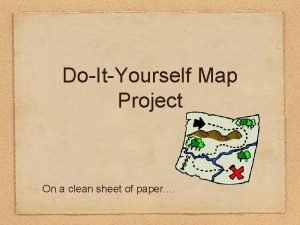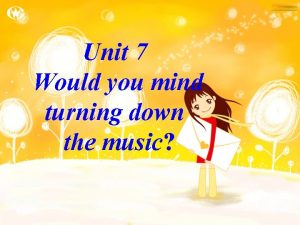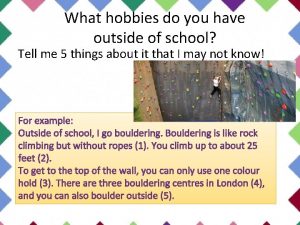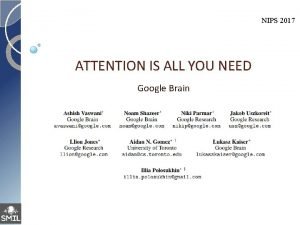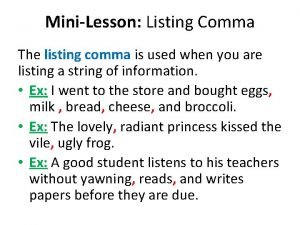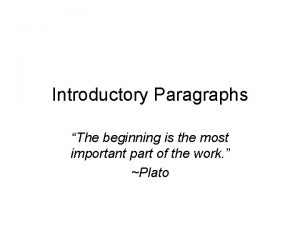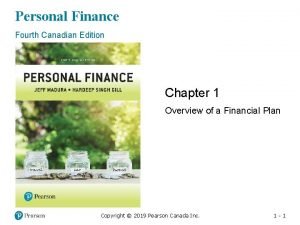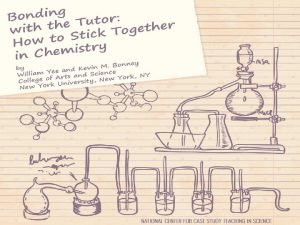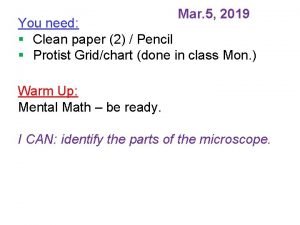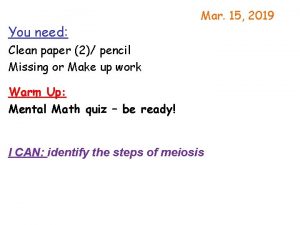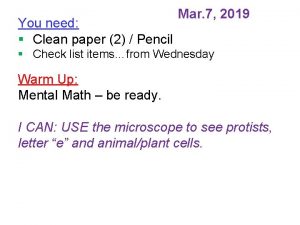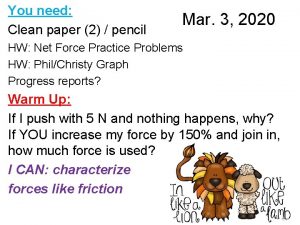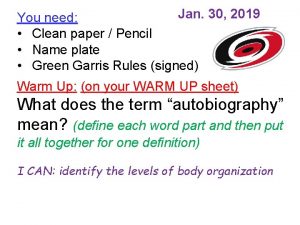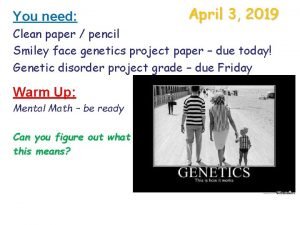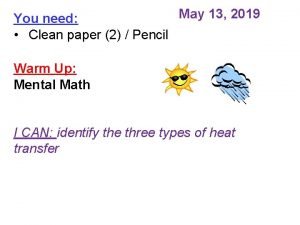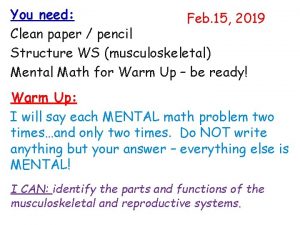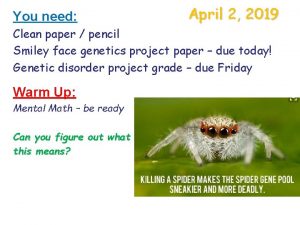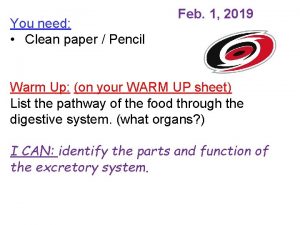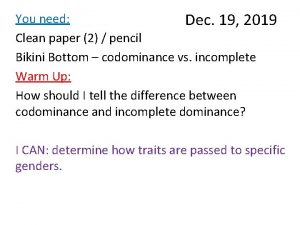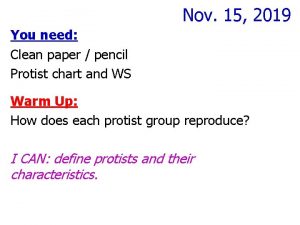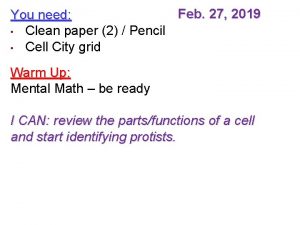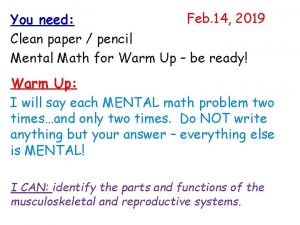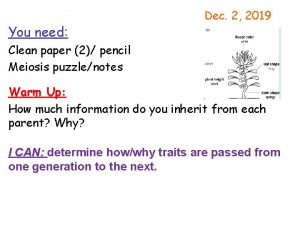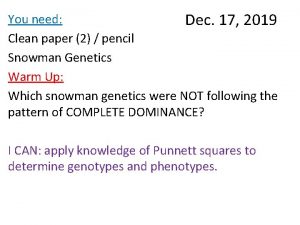You need Mar 12 2019 Clean paper 2


























































- Slides: 58

You need: Mar. 12, 2019 Clean paper (2)/ pencil Mitosis puzzle and notes Warm Up: Mental Math quiz – be ready! I CAN: identify the steps of mitosis and meiosis

Today’s agenda • • • Mental Math Cougar Mtn Finish Mitosis notes Brain. Pop / Quiz Meiosis…? (puzzle, notes, compare)

S I S O T I M

Starting point: You want to start with one cell that has 100% of the genetic information (like a normal body cell). To keep things simple, we will work with a cell that has 4 chromosomes in a normal body cell.

Your goal: To create TWO cells that each have 100% of the genetic information. These would have FOUR chromosomes each…and look just like the original.

START Anaphase Interphase Prophase Telophase Metaphase Cytokinesis

Did you reach the goal? Two cells and each has exactly 100% of the genetic material? Is the genetic material the same in these cells? Is that good or bad? Why?

Mitosis – from the Amoeba sisters • Watch this You. Tube video from a group that call themselves the Amoeba sisters!

Inside the nucleus, are CHROMOSOMES small packages of DNA comes from both your mom and your dad.

Chromosomes contain the genetic material of an organism. This genetic material is organized into packets of information called genes. Genes give the instructions for an organism’s traits or physical features. Chromosome = a package of genetic information that can be passed from parent to offspring. GENE: info from Mom about eye color AND from Dad about a trait (like eye color).

How do little elephants grow up to be BIG elephants?

Why do animals shed their skin?

The process of asexual reproduction begins after a sperm fertilizes an egg.

Three reasons why cells reproduce by asexual reproduction: 1. Growth 2. Repair 3. Replacement

Animated Mitosis Cycle http: //www. cellsalive. com/mitosis. htm • Interphase • Prophase • Metaphase • Anaphase • Telophase & Cytokinesis

Animal Mitosis -- Review Interphase Prophase Metaphase Anaphase Telophase Interphase

Plant Mitosis -- Review Interphase Prophase Metaphase Anaphase Telophase Interphase

Interphase Description of events: • Centriole pair replicates. • DNA replicates to create duplicated chromosomes. • Most of the cell’s life is spent in INTERPHASE

Interphase Animal Cell Plant Cell Photographs from: http: //www. bioweb. uncc. edu/biol 1110/Stages. htm

o r P e s a h p Description of events: • Centriole pair begins to migrate to opposite poles. • Nuclear membrane begins to dissolve. • Spindle fibers begin to form between centriole pairs. • Duplicated chromosomes begin to condense. • Nucleolus begins to disappear.

Prophase Plant Cell Animal Cell Spindle fibers Centrioles Photographs from: http: //www. bioweb. uncc. edu/biol 1110/Stages. htm

Me ta ph as e Description of events: • Centriole pairs are fully migrated to opposite poles. • The spindle apparatus is fully formed. • Spindle fibers have moved the duplicated chromosomes so that they line up at the midline of the cell. • Nuclear membrane has completely disappeared. • Duplicated chromosomes are at their most condensed at this stage.

Metaphase Animal Cell Plant Cell Photographs from: http: //www. bioweb. uncc. edu/biol 1110/Stages. htm

Description of events: • Spindle fibers pull the sister chromatids apart at the centromere and drag them to opposite poles. • The cell elongates (gets longer – like an oval) Anaphase

Anaphase Animal Cell Plant Cell Photographs from: http: //www. bioweb. uncc. edu/biol 1110/Stages. htm

Description of events: • The cell begins cytokinesis by forming a cleavage furrow (pinch) to divide the cytoplasm. • Nuclear membranes begin to reform around the separate (but identical) sets of chromosomes. • Spindle apparatus has disassembled and the spindle fibers dissolve. • Chromosomes begin to decondense. • Nucleolus begins to re-form. Telophase

Telophase Animal Cell Plant Cell Photographs from: http: //www. bioweb. uncc. edu/biol 1110/Stages. htm

Description of events: • The two identical daughter cells are completely separated. • Spindle fibers have completely disappeared. • The chromosomes are completely de-condensed and lengthened. • The nucleolus is very distinct. • The nuclear membrane has completely re-formed around the chromosomes. Af cy ter to ki n es is

Check over your work!!

Interphase Description of events: • Centriole pair replicates. • DNA replicates to create duplicated chromosomes. • Most of the cell’s life is spent in INTERPHASE Description of events: • Spindle fibers pull the sister chromatids apart at the centromere and drag them to opposite poles. • The cell elongates (gets longer – like an oval) Anaphase Description of events: • The cell begins cytokinesis by forming a cleavage furrow (pinch) to divide the cytoplasm. • Nuclear membranes begin to reform around the separate (but identical) sets of chromosomes. • Spindle apparatus has disassembled and the spindle fibers dissolve. • Chromosomes begin to decondense. • Nucleolus begins to re-form. Telophase Prophase Description of events: • Centriole pair begins to migrate to opposite poles. • Nuclear membrane begins to dissolve. • Spindle fibers begin to form between centriole pairs. • Duplicated chromosomes begin to condense. • Nucleolus begins to disappear. Metaphase Description of events: • Centriole pairs are fully migrated Description of events: to opposite poles. • The two identical daughter cells • The spindle apparatus is fully are completely separated. formed. • Spindle fibers have completely • Spindle fibers have moved the disappeared. duplicated chromosomes so that • The chromosomes are they line up at the midline of the completely de-condensed and cell. lengthened. • Nuclear membrane has • The nucleolus is very distinct. completely disappeared. • The nuclear membrane has • Duplicated chromosomes are at completely re-formed around their most condensed at this the chromosomes. stage. After cytokinesis


Mitosis Hand Jive! • Here are two videos that explain the hand motions used to represent phases of mitosis. Watch them both!!! Bill Ry the science guy EXPLAINS the hand signals. Ms. Loree dances through the mitosis hand signals.

Mnemonic Device • Sometimes it helps us to remember things if we put it into a song, or hand signals, or a crazy sentence. • You may have used “Please Excuse My Dear Aunt Sally. ” The first letter of each word matches the steps in the order of operations (parentheses, exponents, multiply/divide, add/subtract). • Come up with a Mnemonic Device using the letters of the phases of mitosis (IPMATC). Turn it in through Google Classroom

REMEMBER! Interphase Prophase Metaphase Anaphase Telophase Cytokinesis IPMATC Iguanas Pee More Accurately Than Cats.

E L Z Z ! U ! P ME I S I T S O I E M

Starting point: You want to start with one cell that has 100% of the genetic information (like a normal body cell). To keep things simple, we will work with a cell that has 4 chromosomes in a normal body cell.

Your goal: To create FOUR cells that only have 50% of the genetic information. These would only have TWO chromosomes (NOT 4).

Puzzle check • Knowing if you have the right process is tricky. Let’s try watching the steps. • Cells Alive! (meiosis)

Starting point: You want to start with one cell that has 100% of the genetic information (like a normal body cell). To keep things simple, we will work with a cell that has 4 chromosomes in a normal body cell.

After we start… Before we can split to smaller groups, we need to copy the information. This reminds me of mitosis!

Once copies have been secured (copy and original are sticking together!), then we line them up… Metaphase

After lining up in the MIDDLE, we have to split. This is different than MITOSIS, though. How? In MITOSIS, the chromosomes line up in the middle vertically and all four would split in half. But in MEIOSIS, they have split the total in half – not the chromosome and it’s copy!

After the ONE nucleus splits into TWO nuclei, we still need to split the original chromosome from it’s copy.

Lining up in the MIDDLE – like Metaphase…AGAIN!! This time they are ready to separate the original chromosome and it’s copy.

Each chromosome (copy and original is separated. Now the TWO look like they are becoming FOUR.

Did you reach the goal? Four cells and each has only ½ of the genetic material? Is the genetic material the same as each of the other cells? If not all of these cells have the same genetic information, is that bad or good? Why?

Cheat / Hint: 64258173

Meiosis • NOT Mitosis • Used to create a cell that has ONLY 50% of DNA • Happens in the SEX ORGANS • Allows for different combinations of DNA

MITOSIS MEIOSIS -my-TOES-es -my-OH-sis -happens all over the body -happens only in ONE place (sex organs) -start with a “normal” body cell (100%) and end with TWO “normal” cells (100% each) -exact copy -start with a “normal” body cell (100%) and end with several sex cells (50% each) -allows for different combos of genes…and that helps strengthen the species. -Sperm = boys; egg = girls

Mitosis vs. Meiosis Flip Book • Cut/color/paste • Title page • Venn diagram (with sorted info) • Pictures of phases…color/label




Mitosis vs. Meiosis Flip Book • Cut/color/paste • Title page • Venn diagram (with sorted info) • Pictures of phases…color/label

B. Nucleus Chromosome C. A. CELL D. DNA E. A gene


Chromosome = a package of genetic information that can be passed from parent to offspring. Gene = one SET of alleles (one from each parent) about a given trait…example: eye color.

Review and vocabulary Pedigree Parent Filial / offspring Generations Traits Chromosomes Dominant (gene) Recessive (gene) We will add more as we go.
 Clean up everybody let's clean up
Clean up everybody let's clean up Astroturf lobbying
Astroturf lobbying Copy the diversity card on a clean sheet of paper
Copy the diversity card on a clean sheet of paper On a clean sheet of paper draw yourself
On a clean sheet of paper draw yourself I wish you all the strength
I wish you all the strength You control your destiny you don't need magic to do it
You control your destiny you don't need magic to do it English literature edexcel past papers
English literature edexcel past papers Aqa inspector calls
Aqa inspector calls Ks1 sats papers 2019
Ks1 sats papers 2019 Aqa english literature paper 1 2019 a christmas carol
Aqa english literature paper 1 2019 a christmas carol How do you keep your city clean for class 2
How do you keep your city clean for class 2 I have told you to clean your room a million times
I have told you to clean your room a million times Would you mind turning the music down
Would you mind turning the music down Please clean the room before you live
Please clean the room before you live Please clean your own room
Please clean your own room Please clean the room before you live
Please clean the room before you live English general paper paper 2 comprehension
English general paper paper 2 comprehension The hand approach general paper
The hand approach general paper You need a passport to cross the
You need a passport to cross the English paragraph
English paragraph You only need to be lucky once
You only need to be lucky once Attention is all you need.
Attention is all you need. Example of why oxford comma is important
Example of why oxford comma is important Love is not all you need
Love is not all you need How many sentences do you need in a introduction
How many sentences do you need in a introduction Fsa writing format
Fsa writing format Where to sign passport
Where to sign passport Recognizing genre - argumentative text answer key
Recognizing genre - argumentative text answer key Everything you need to know about the odyssey
Everything you need to know about the odyssey Low and high friction
Low and high friction Expressways have fewer collisions than highways because
Expressways have fewer collisions than highways because 2 choose the correct answers
2 choose the correct answers Let's be good friends
Let's be good friends You need to make at least 150 sandwiches for a picnic
You need to make at least 150 sandwiches for a picnic Much do you need health
Much do you need health For you have need of endurance
For you have need of endurance Lord i come i confess
Lord i come i confess All i need is the air that i breathe and to love you abba
All i need is the air that i breathe and to love you abba Everyone warned you tag question
Everyone warned you tag question Money is all you need
Money is all you need Lindell cooley i need you more
Lindell cooley i need you more You say you love rain
You say you love rain Agree or disagree questions about life
Agree or disagree questions about life If you think you can you can poem
If you think you can you can poem Tell me what you eat and i shall tell you what you are
Tell me what you eat and i shall tell you what you are Whereever you go i will follow
Whereever you go i will follow Place value gcse questions
Place value gcse questions Error intervals
Error intervals H-n-h-h polar or nonpolar
H-n-h-h polar or nonpolar Whatispersonalhygiene
Whatispersonalhygiene Wet etch clean and filter
Wet etch clean and filter Clean spreaders and check wheel-driven gears
Clean spreaders and check wheel-driven gears What is the theme of katie clean and messy missy story
What is the theme of katie clean and messy missy story Introductory paragraph for persuasive essay
Introductory paragraph for persuasive essay Figurative language in the song a thousand miles
Figurative language in the song a thousand miles Clean energy smart manufacturing innovation institute
Clean energy smart manufacturing innovation institute How did the romans keep clean
How did the romans keep clean Clean up your shack
Clean up your shack Direct indirect speech worksheet
Direct indirect speech worksheet



